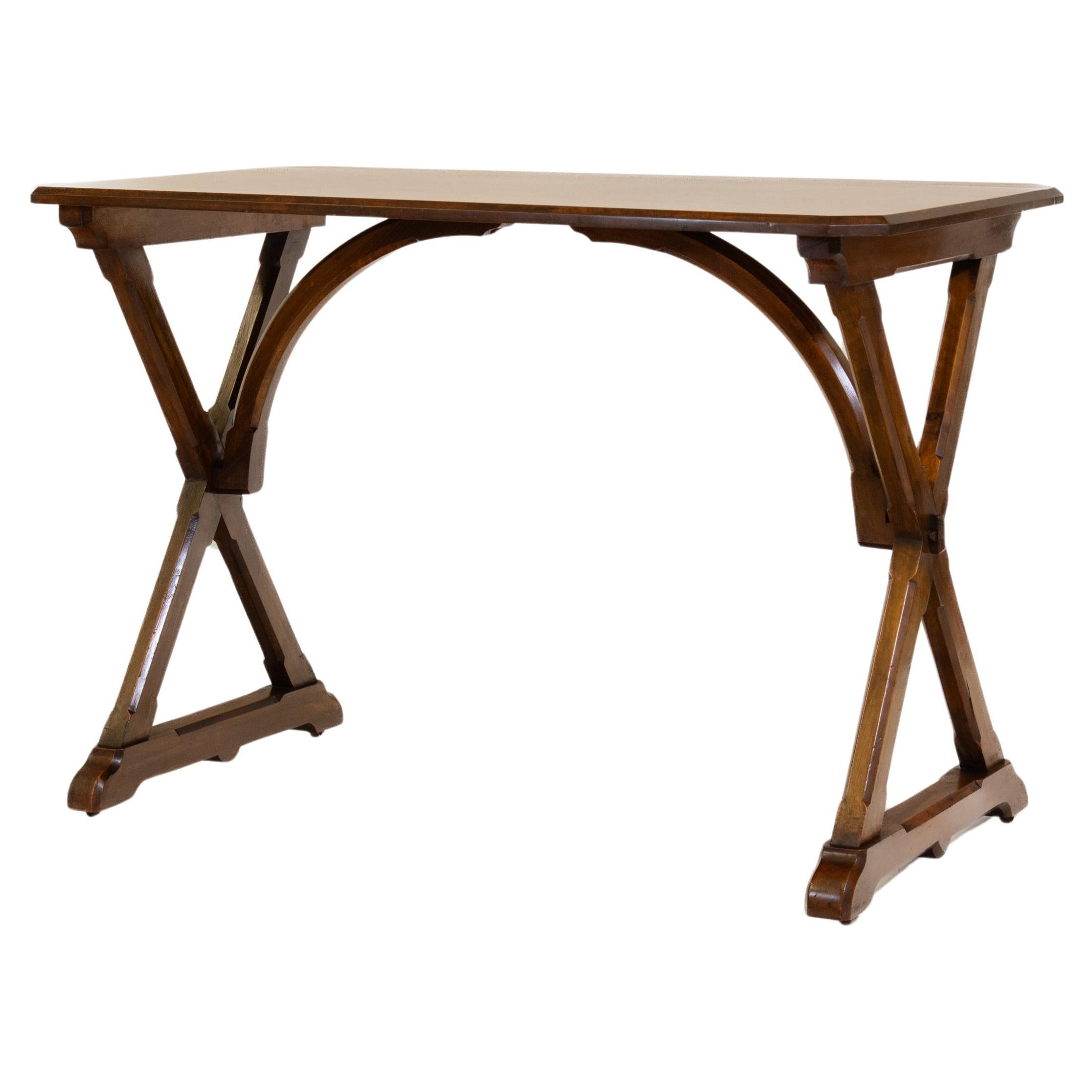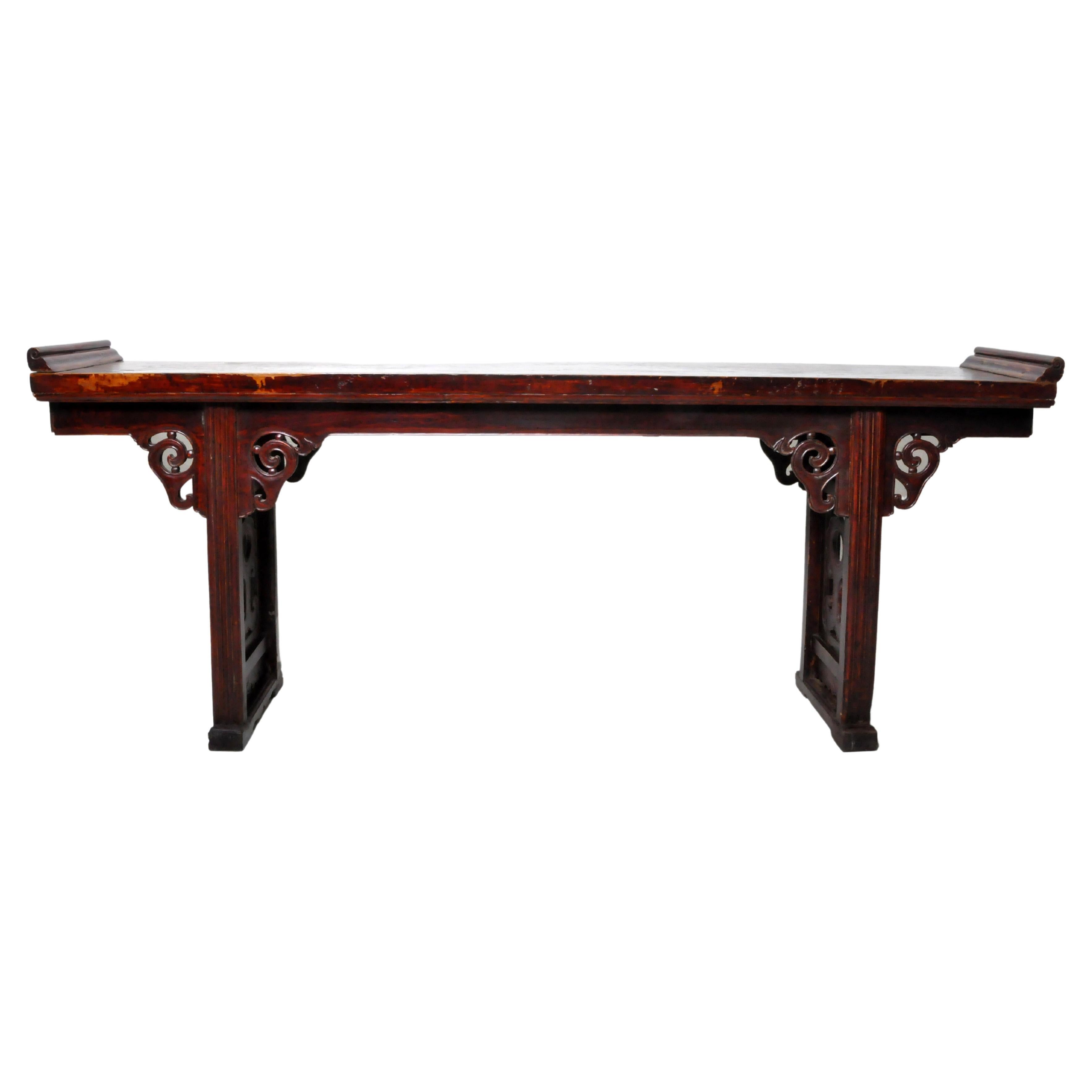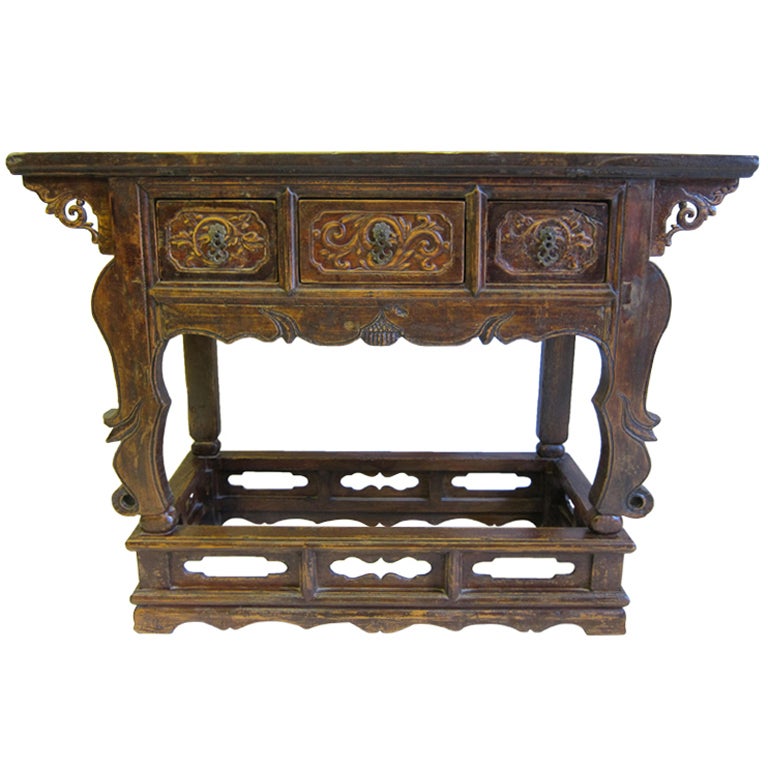Items Similar to 19th Century Victorian Gothic Revival Ecclesiastical Altar Table Attrib Pugin
Want more images or videos?
Request additional images or videos from the seller
1 of 21
19th Century Victorian Gothic Revival Ecclesiastical Altar Table Attrib Pugin
About the Item
A rare grand Victorian Gothic religious church altar attributed to A.W.N Pugin (1812-1852)
Hand-crafted of solid pine in the first half of the 19th century, having a removable octagonal top over conforming architectural well-form pedestal base with heavy-duty braced open interior, arched molding, quatrefoils and attractive paneling.
Pugin, Augustus Welby Northmore, London, architect, designer and cm (b. 1812–d. 1852). Pugin's career as England's most celebrated Gothic Revival architect is too well known to detain us here; his little known foray into the realm of cabinet making however, is relevant. Pugin was from 1827–29 employed as the designer of a wide range of Gothic Revival furniture for Windsor Castle. This furniture was manufactured to his designs by Morel & Seddon and much of it still survives in situ. In 1829 Pugin noted in his fragmentary autobiography ‘Novr. 23 began business for myself in the carving and joinery line at 12 Hart Street, Covent Garden. At this time I had only the upper loft’. [V & A Lib., L.5204–1969 f. 30] Hart St is now named Floral St. Pugin was also working at this time as a stageman at the nearby Covent Gdn Theatre. His business was a pioneering one for ‘In those days great difficulty was felt in finding artificers and carvers capable of doing justice to the execution of designs in the mediaeval style … young Pugin now proposed not only to undertake the delineation of working drawings, but also to superintend the execution of work which he designed’. [Ferrey, pp. 64–65] No bills, accounts or other documents of the firm survive and Pugin's name does not appear in the rate bks, probably because he rented the premises. [Wainwright, p. 5] As shown below only four commissions are documented and only three of these are certainly for furniture. Pugin's firm manufactured carved details as well as furniture and ‘Would undertake to supply all the ornamental portions of a building which could possibly be executed apart from the structure and fixed afterwards’. [Ferrey, p. 65] Pugin certainly supplied carved details and possibly furniture to Murthly Castle in 1830 and 1831 [Macaulay, pp. 248–49] which was then being built to the designs of his friend the architect James Gillespie Graham. Pugin almost certainly also designed and possibly furnished the interiors at Murthly: ‘… I designed all the interior decoration of a large mansion for Mr Gillespie Graham … in the style of James I, the drawing room in the style of Louis 14th.’ [V & A Lib., L.5204–1969 f. 29] The furniture manufactured by the firm was not only Gothic in the manner of Pugin's Windsor pieces, but Jacobean as at Murthly and at times Tudor also. A considerable number of furniture designs by Pugin survive from this period [Wedgwood, 1977]; how many were executed is unknown. A group of designs in the Gothic and Jacobean styles survive [Wedgwood, 1985] which were certainly executed for Mrs John Gough of Perry Hall. The Pugin letters which accompany them cover the period June 1830–September 1831 and provide more information concerning the activities of his firm than is available from any other source. None of this furniture is known to survive. The firm was short lived, for in 1831 Pugin ‘… not being brought up as a man of business was incapable of estimating the sufficient profit he attached to labour and materials in order to secure a proper return on invested capital … he was sued for non-payment of rent and placed in a sponging house … he must have become bankrupt but for the final discharge of his liabilities by Miss Welby his aunt’. [Ferrey, pp. 66–68] In September he wrote to Mrs Gough ‘… I have at length determined to relinquish the execution of work myself altogether to confine myself entirely to my original profession of an architect and designer’. [V & A, Print Dept, E.65–1955] He never again ran a business, only working as an architect for the usual fees. The history of this short-lived firm is important not only because of Pugin's fame as an architect, but also because of the advanced character of the carving and furniture which it produced. The pieces in the Jacobean and Tudor styles particularly were to be emulated in so many pieces made by other firms in the later 1830s and 1840s. Only two pieces made by this firm are known to survive, that mentioned below and a Tudor style oak table in the V & A which is stamped ‘A. PUGIN’. [Wainwright, p. 5] [B. Ferrey, Recollections of A. W. N. Pugin and his father Augustus Pugin, 1861; J. Macaulay, The Gothic Revival, 1745–1845, 1975; A. Wedgwood, Catalogue of the Drawings Collection of the Royal Institute of British Architects the Pugin Family, 1977; A. Wedgwood, Catalogues of Architectural Drawings in the Victoria and Albert Museum, A. W. N. Pugin and the Pugin Family, 1985; C. Wainwright, ‘A. W. N. Pugin's Early Furniture’, Conn., CXCI, no. 767, 3–11] PERRY HALL, Warks. (Mrs John Gough). Furniture supplied 1830–31. [V & A] MURTHLY CASTLE, Perthshire (Sir John Stewart of Grantully). 1830–31. Carved details and possibly furniture. [Macaulay] WESTON HOUSE, Warks. (Sir George Philips) 1830–31. Furniture and possibly carvings. [Pugin letters noted by Warwick RO in 1932 as in house, now lost] PRIORY CHURCH OF HOLY TRINITY, Christchurch, Hants. 1831. The altar table, which is still in situ, bears the inscription ‘This table was made and presented to this church by Augustus Welby Pugin AD 1831’. The design also exists. [Wedgwood, 1977, p. 43] C.W.
Dimensions (approx):
38.5" High, 43.25" Wide, 36"Deep
Please note, at some point a back section was cut off so this altar table could be placed up against a wall, so one back section is unfinished.
Overall in great antique condition. Solid/sturdy. Structurally sound. Warm rich wood tones and grain detail. Delivered cleaned, waxed, polished and ready for use.
- Dimensions:Height: 38.5 in (97.79 cm)Width: 43.25 in (109.86 cm)Depth: 36 in (91.44 cm)
- Style:Gothic Revival (Of the Period)
- Materials and Techniques:Pine,Wood,Hand-Crafted
- Place of Origin:England
- Period:19th Century
- Date of Manufacture:circa 1840
- Condition:Additions or alterations made to the original: Please note, at some point a back section was cut off so this altar table could be placed up against a wall, so one back section is unfinished. Wear consistent with age and use. Minor losses. Overall in great antique condition. Solid/sturdy. Structurally sound. Warm rich wood tones and grain detail. Delivered cleaned, waxed, polished.
- Seller Location:Forney, TX
- Reference Number:1stDibs: LU5977226088542
About the Seller
4.8
Platinum Seller
These expertly vetted sellers are 1stDibs' most experienced sellers and are rated highest by our customers.
Established in 2013
1stDibs seller since 2021
200 sales on 1stDibs
Typical response time: <1 hour
- ShippingRetrieving quote...Ships From: Forney, TX
- Return PolicyA return for this item may be initiated within 7 days of delivery.
More From This SellerView All
- 19th Century Gothic Revival Bronze Altar Candlestick PairLocated in Forney, TXA stunning pair of antique Neo-Gothic bronze church altar stick candle prickets with beautifully aged patina. European, late 19th century, each with a single candle socket, mural crown, pierced quatrefoils, wafer stem, rising on paw feet. Dimensions: (approx) 27.25" Tall, 8.25" Diameter; 28lbs total Condition: Great original unrestored antique condition with nicely aged dark warm patinated finish. Distinctive gilt brass and copper like tones. Wear consistent with age and indicative of use. Overall outstanding examples World Wide Shipping Available Local Pickup/Delivery available around Dallas, Texas We here at Lynx Hollow Antiques absolutely love collecting and decorating with religious objects. From a church altar table...Category
Antique Late 19th Century European Gothic Revival Candlesticks
MaterialsBronze
- 19th Century French Ecclesiastical Iron & Bronze Altar RailLocated in Forney, TXA rare and magnificent architectural ecclesiastical iron and bronze altar railing. Created in France in the 19th century, commissioned for a Victorian er...Category
Antique 19th Century French Gothic Revival Religious Items
MaterialsBronze, Iron
- 19th Century English Victorian Gothic Revival Rainwater HopperLocated in Forney, TXAn impressive English Victorian Gothic Revival cast iron rainwater hopper, the architectural salvaged building element originating from a late 19th ce...Category
Antique 19th Century Gothic Revival Architectural Elements
MaterialsIron
- 19th Century Portuguese Renaissance Revival Trestle TableLocated in Forney, TXA most distinctive antique, circa 1870, Portuguese Renaissance Revival carved walnut trestle table with beautifully aged warm, rich dark patina! Born in Portugal during the second h...Category
Antique 19th Century Portuguese Renaissance Revival Tables
MaterialsWalnut
- 19th Century Religious Hand-Painted Altar Triptych Icon Ecclesiastical ArtLocated in Forney, TXA beautiful 19th century hand carved and painted partial git live edge wooden triptych retable church altarpiece, depicting "The Bible Parable of the Prodigal Son". The European antique, believed to be Spanish in origin, comprised of three gothic cathedral architectural steeple shaped brilliant gold gilded solid wood panels affixed with brass hinges, opening to reveal a trio of rich polychrome decorated religious folk art works. A most impressive display of Catholic Saint / Santos figures, one on horse, the other on donkey, red and yellow coat of arms shield with lion rampant crest insiginia, having later wall hanging wire hardware mounted on the center back painting, allowing for easy hanging, or freestanding to conveniently display the work on a console table, desk, or shelf. With beautiful, bright, rich coloring, warm hues, and distinctive rustic wood grain patterns on both sides, this remarkable example makes for a truly special, thoughtful one-of-a-kind gift, Communion, birthday or holiday. Highly decorative, exceptionally executed design, and unique sculptural silhouette add a touch of sophisticated artistic elegance and cozy relaxed warmth as antique decor,.or as a lovely addition to your home altar, prayer room or devotional shrine, while the folding form is the ideal size for use as a portable / traveling religous icon. Nicely aged patina over the whole., with age appropriate wear, light organically distressed finish, weathered, chippy paint loss, and striking craquelure only adds to the overall antique character and authenticity , historical depth, and European old world charm. Dimensions: (approx) Fully extended: 13.5" H x 17.25" W x 1.5" D Closed: 13.5" H, 3.5" D Provenance : A fine private Raleigh, NC estate. We love decorating with religious antiques, and currently have a large collection available for sale, including various 16th, 17th, 18th, 19th, and 20th century folk art, liturgical altar stick candlesticks, rare relics, altars altar tables, processional pole...Category
Antique 19th Century European Gothic Revival Religious Items
MaterialsIron
- 19th Century French Gothic Revival Carved Bibliothèque BookcaseLocated in Forney, TXA magnificent 19th century Gothic Revival hand carved painted parcel gilt bibliothèque (bookcase - buffet - china cabinet). Born in France, circa 1840, most impressive size, two-...Category
Antique 19th Century French Gothic Revival Bookcases
MaterialsGlass, Wood, Paint
You May Also Like
- Large Scale Victorian Ecclesiastical Gothic Revival Table in the Manner of PuginBy Augustus Welby Northmore PuginLocated in Llanbrynmair, GBA superb 19th century Gothic Revival centre table in the manner of A.W.N Pugin (unattributed). Would make a wonderful serving table or large console table. Narrow form make this piec...Category
Antique 19th Century British Gothic Revival Center Tables
MaterialsOther
- 19th Century Gothic Revival Walnut Writing Side Table A W Pugin MannerBy Augustus Welby Northmore PuginLocated in Norwich, GBA 19th Century burr walnut and walnut Gothic Revival writing side table in the A W Pugin manner. English. Circa 1860. The table having a burr walnut top with canted corners, support...Category
Antique 19th Century English Gothic Revival Desks and Writing Tables
MaterialsWalnut, Burl
- 19th Century Gothic Revival Center Table in the manner of PuginLocated in Troy, NYCenter table in the manner of Pugin, the rectangular top above a carved frieze featuring family crests supported by six open carved square legs, joined by double H-stretcher.Category
Antique 19th Century English Gothic Revival Center Tables
MaterialsOak
- Pair of Italian 19th Century Neo-Gothic Console TablesLocated in Rome, ITA pair of high curiosity neo-Gothic console tables of architectural form. Ebony painted wood with painted glass insert and painted imitation marble top. Sicily, 19th century. Meas...Category
Antique Late 19th Century Italian Gothic Revival Console Tables
- 19th Century Chinese Altar TableLocated in Chicago, ILThis long, elegant altar table once provided a place to burn incense or display valuable art objects. It may have been used in the reception hall of a private mansion or in an ancestral shrine...Category
Antique Mid-19th Century Chinese Console Tables
MaterialsElm
- 19th Century Chinese Altar TableLocated in New York, NYImperial 19th Century Carved Wine Table raised on stand with three drawers. Exceptional table having scalloped apron with carved spandrels and carved Rams legs front set on stand of...Category
Antique 19th Century Chinese Console Tables
MaterialsElm
Recently Viewed
View AllMore Ways To Browse
Made Good
Items From France
Table Top Items
Top Antique Items
Antique Victorian Items
Remove Item
Rare Antique Items
Antique Wood Items
19th Century French Items
Victorian Wax
Antique Church Furniture Furniture
Octagonal 19th Century
19th Century French Center Piece
Wood Altar
19th Century Gothic Revival
Victorian Center Piece
19th Century French Gothic Furniture
Antique Victorian Wood Architecturals





